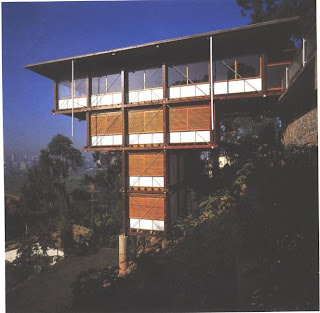CONTEMPORARY PRECEDENTS
 The Marika-Alderton House by Glenn Murcutt, Yirrkala Community, Eastern Amheim Land, Northern Territory
The Marika-Alderton House by Glenn Murcutt, Yirrkala Community, Eastern Amheim Land, Northern Territory Troppo Architects, Lawton Retreat (The Cubby House)
Troppo Architects, Lawton Retreat (The Cubby House)
Juvenal Baracco, Gezzi House, Lima, Peru
 Gabriel Poole, Poole House, QLD
Gabriel Poole, Poole House, QLD
Marcos Acayaba, Residencia Olga, Sao Paulo, Brazil
TRADITIONAL SOUTH EAST ASIAN CONSTRUCTION
- Traditional construction methods
- Solutions to climatic problems that have been developed over long periods of time, what Glen Murcutt identfies in his book “Touch this Earth Lightly” as being the only way to truly regional style that belongs to an area.
- Traiditional Sarawak buildings tend to be communal, social outdoor spaces, many dwelling side by side, integrated.
- Walkway and steps, made purely for purpose, end up being beautiful in their erratic nature. Sometimes require or imply a journey into dwelling.
- Made of local produce therefore fit in seamlessly with local landscape.
- Minimal requirements for living, interiors that aid cooking, living, sleeping and social interaction but do not put up a barrier between nature and man, not an artificial environment.
- Big roofs, big roof spaces, mostly quite steeply pitched
- Sometimes extremely high “ceiling heights”
- Raised above ground level, sometimes quite high- how high can you go.
- Cubby house feel- series of ladders, mezzanines, steps, walkways = journey through spaces, communal living. Private vs communal spaces.
- Traditional construction methods
- Solutions to climatic problems that have been developed over long periods of time, what Glen Murcutt identfies in his book “Touch this Earth Lightly” as being the only way to truly regional style that belongs to an area.
- Traiditional Sarawak buildings tend to be communal, social outdoor spaces, many dwelling side by side, integrated.
- Walkway and steps, made purely for purpose, end up being beautiful in their erratic nature. Sometimes require or imply a journey into dwelling.
- Made of local produce therefore fit in seamlessly with local landscape.
- Minimal requirements for living, interiors that aid cooking, living, sleeping and social interaction but do not put up a barrier between nature and man, not an artificial environment.
- Big roofs, big roof spaces, mostly quite steeply pitched
- Sometimes extremely high “ceiling heights”
- Raised above ground level, sometimes quite high- how high can you go.
- Cubby house feel- series of ladders, mezzanines, steps, walkways = journey through spaces, communal living. Private vs communal spaces.





ARCHITECTS WITHOUT FRONTEIRS:
18th August 2009
-“Parasol roofing”
-Aboriginal senses keenly tuned to the environment, sorcery, spirituality of the land.
- Establishing micro climates between roof and ceiling?
- Partly pre-fab/ partly built on site?
- Move it around?
- Although design techniques were covered in the lecture, for the NT Kakadu component, this topic was more comprehensively covered for the W.A site. The Kakadu project was less resolved and therefore discussion was based more around initial consultation, client requirements and getting a feel for the site which was valuable.
.jpg)


TEN CANOES
Thoughts about Kakadu:
-Timelessness
-Colours, noted the different sets of colours during different parts of the days/different season
-Last camp scene/dance scene, got me thinking about how our Domus will function at night, a time when a lot of socialisation and relaxation takes place. Creating a social night time space.
-Although “Tropical” and green , still has that dry Australian “white” light which is stark against dryer grasslands.
-Inspiration: the formations of the warriors/hunters with their spears. Cinematography which demonstrates how well the indigenous people and they’re creations (ie: canoes, huts spears) are in harmony with the landscape and how integrated they are. See sketches.
- “Don’t leave your shit lying around” , running theme through the movie, to leave your shit, the hair cut from your head on hair cut day or perhaps a dead body around is to cause trouble. Leave no waste on the land.
-Scenes of treehouses, the men that are goosehunting live, eat and sleep in the trees for that time. Build treehouses right above the river.
-Sense that there are a lot of other inhabitants (spirits, other tribes, animals etc) on the land, and it is inherently social (even amongst conflict). The buildings should reflect this “coming and going” and interaction. A building too insular would be spooky and isolating.
Thoughts about Kakadu:
-Timelessness
-Colours, noted the different sets of colours during different parts of the days/different season
-Last camp scene/dance scene, got me thinking about how our Domus will function at night, a time when a lot of socialisation and relaxation takes place. Creating a social night time space.
-Although “Tropical” and green , still has that dry Australian “white” light which is stark against dryer grasslands.
-Inspiration: the formations of the warriors/hunters with their spears. Cinematography which demonstrates how well the indigenous people and they’re creations (ie: canoes, huts spears) are in harmony with the landscape and how integrated they are. See sketches.
- “Don’t leave your shit lying around” , running theme through the movie, to leave your shit, the hair cut from your head on hair cut day or perhaps a dead body around is to cause trouble. Leave no waste on the land.
-Scenes of treehouses, the men that are goosehunting live, eat and sleep in the trees for that time. Build treehouses right above the river.
-Sense that there are a lot of other inhabitants (spirits, other tribes, animals etc) on the land, and it is inherently social (even amongst conflict). The buildings should reflect this “coming and going” and interaction. A building too insular would be spooky and isolating.




Wonderful - I think this is how a thesis is born!!!
ReplyDelete